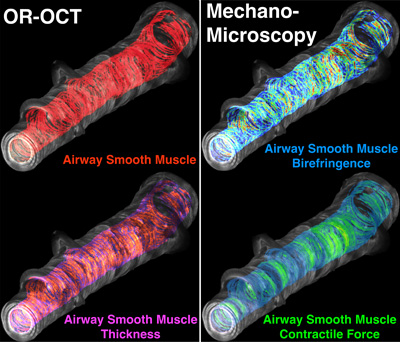
More than 300 million people worldwide are affected by asthma, 25 million in the U.S. alone, and for most of them, allergy is an underlying cause. But why do some individuals allergic to airborne allergens develop asthma while many others do not?
Now, two research teams from Harvard Medical School and Massachusetts General Hospital have used innovative imaging technology and other novel approaches to identify some key differences in both the immune response and the sensitivity of airway cells to inflammation between allergic individuals with and without asthma.
Their results are reported in companion papers appearing in Science Translational Medicine.
“Our study found that, despite similar levels of systemic allergy response, allergen-specific CD4 helper T cells in individuals with asthma had a more potent response to airway allergens than did allergic individuals without asthma,” said Andrew Luster, the HMS Persis, Cyrus and Marlow B. Harrison Professor of Medicine at Mass General, who led one research team along with Benjamin Medoff, HMS associate professor of medicine at Mass General. “Second, the airway cells of asthmatic individuals were both structurally different and have a greater response to allergens and to allergy-associated inflammation.”
Several of the findings of Luster’s team depended on the ability to analyze, for the first time in living patients, the structure and function of the airway smooth muscle cells that contract and obstruct the airway during an asthma attack. This was made possible by a novel imaging technique developed by the other team, led by Melissa Suter, HMS assistant professor of medicine at Mass General. This team developed an advanced version of optical coherence tomography (OCT), a Mass General-invented technology that provides high-resolution imaging of the structure of many types of tissue.
“Although in theory OCT has the resolution necessary to see airway smooth muscle, it doesn’t provide sufficient contrast against the surrounding airway tissues to do so,” said Suter. “Standard OCT generates images by measuring the amount of light that is reflected back from tissue, but there is more information in the returning light than just how much is reflected back.”
When light travels through organized tissue, which smooth muscle is, different aspects of the light will travel at different speeds depending on the orientation of the tissues.
“The ability to measure orientation-dependent properties, like light polarization, lets us know how airway smooth muscle is organized,” Suter said.
Suter’s team developed a microscopic imaging platform that provides both orientation-resolved OCT (OR-OCT) images, which reveal the amount of airway smooth muscle, and mechano-microscopy, which measures the force with which muscle tissue contracts. After validating the ability of their equipment to do so in segments of animal airway, the researchers collaborated with Luster’s group to assess the structure of airway smooth muscle in six volunteer study participants: three with mild allergic asthma and three with no allergy. They found that airway smooth muscle was two times thicker in participants with asthma.
Luster’s study used Suter’s technology and several other approaches to investigate differences in the airway response to allergens among 36 participants with mild allergic asthma, 48 with allergies but no history of asthma, and 5 healthy control participants.
After initial measurements of participants’ airway smooth muscle using OR-OCT, researchers introduced diluted amounts of the appropriate allergen—either cat dander or dust mites—into a small section of participants’ lungs. They then measured numerous aspects of the immune response within the lungs, with particular attention to inflammation and to characteristics of the CD4 T cells that specifically respond to the allergen in question.
Both allergic patients with and those without asthma responded to the allergen challenge with type 2 inflammation, the type that is characteristic of allergy, and both groups were found to have similar levels of several types of T cells. But use of a novel tool developed in the laboratory of James Moon, HMS assistant professor of medicine at Mass General—an immunologic agent that recognizes allergen-specific T cell receptors—allowed the team to identify and analyze allergen-specific CD4 T cells in participants’ airways.
While both participants with asthma and those without asthma had increases in these allergen-specific CD4 T cells after the allergen challenge, cells in participants with asthma showed markedly higher expression of two receptors for type 2 innate immune signals.
A collaborator with Luster’s team, Mehmet Kesimer from the University of North Carolina at Chapel Hill, analyzed both the amount and the consistency of mucus secreted in participants’ airways in response to the allergen challenge. In asthmatic participants he found both larger amounts of mucus and increased levels of a protein that makes mucus more gelatinous and may increase airway hyper-reactivity.
Use of OR-OCT to measure both the thickness of airway smooth muscle and the width of the bands of muscle that wrap around the airway showed significantly greater smooth muscle mass in participants with asthma than in either allergic participants without asthma or in healthy controls.
“Recognizing that the response of airway structural cells to allergens and to type 2 inflammation appears to be critical for the development of allergic asthma is an important step forward,” said Luster. “If we are able to understand the mechanisms that determine the sensitivity of the epithelial and smooth muscle cells of the airway to inflammation in asthma, we could identify novel targets to treat or reverse asthma, possibly even to prevent its development in allergic individuals.”
Determining the precise role that airway smooth muscle plays in asthma has been difficult, Suter said.
“Our current understanding is based largely on autopsy studies and on biopsy samples,” Suter said. “The ability to image airway smooth muscle and to assess its contractile force in living patients will likely transform the study of asthma—distinguishing between various types of asthma, guiding therapy, and uncovering the true role of airway smooth muscle in asthma and other obstructive lung diseases.”
Support for both studies includes National Institutes of Health grants U19 AI095261, R37 AI040618, R01 CA167827, R01 HL103940, EB105903, T32 HL116275 and K08AI113083.
Adapted from a Mass General news release.


